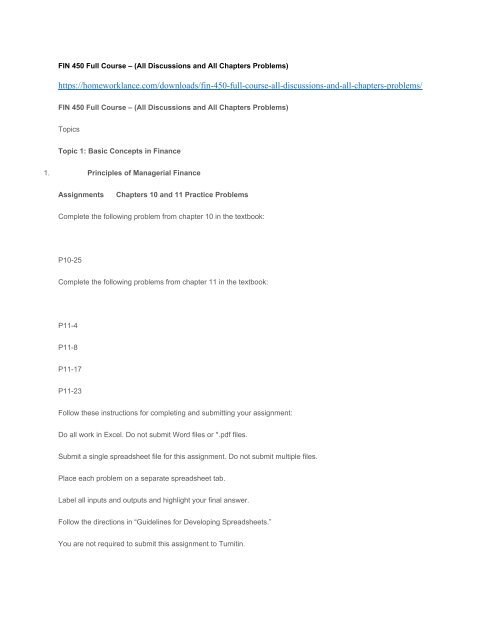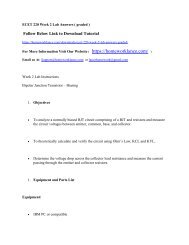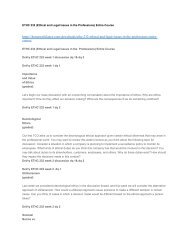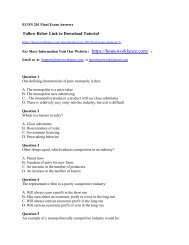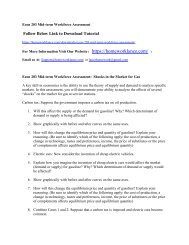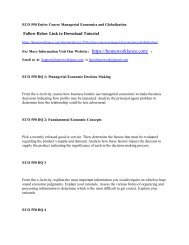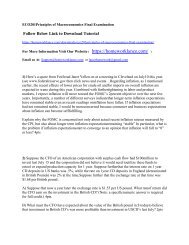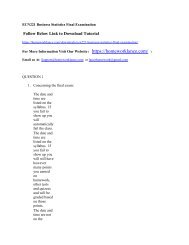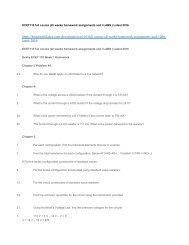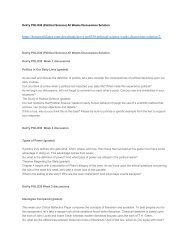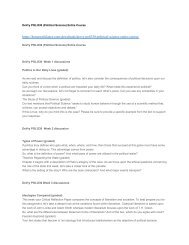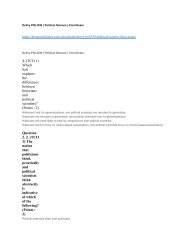FIN 450 Full Course – (All Discussions and All Chapters Problems)
Create successful ePaper yourself
Turn your PDF publications into a flip-book with our unique Google optimized e-Paper software.
<strong>FIN</strong> <strong>450</strong> <strong>Full</strong> <strong>Course</strong> <strong>–</strong> (<strong>All</strong> <strong>Discussions</strong> <strong>and</strong> <strong>All</strong> <strong>Chapters</strong> <strong>Problems</strong>)<br />
https://homeworklance.com/downloads/fin-<strong>450</strong>-full-course-all-discussions-<strong>and</strong>-all-chapters-problems/<br />
<strong>FIN</strong> <strong>450</strong> <strong>Full</strong> <strong>Course</strong> <strong>–</strong> (<strong>All</strong> <strong>Discussions</strong> <strong>and</strong> <strong>All</strong> <strong>Chapters</strong> <strong>Problems</strong>)<br />
Topics<br />
Topic 1: Basic Concepts in Finance<br />
1. Principles of Managerial Finance<br />
Assignments<br />
<strong>Chapters</strong> 10 <strong>and</strong> 11 Practice <strong>Problems</strong><br />
Complete the following problem from chapter 10 in the textbook:<br />
P10-25<br />
Complete the following problems from chapter 11 in the textbook:<br />
P11-4<br />
P11-8<br />
P11-17<br />
P11-23<br />
Follow these instructions for completing <strong>and</strong> submitting your assignment:<br />
Do all work in Excel. Do not submit Word files or *.pdf files.<br />
Submit a single spreadsheet file for this assignment. Do not submit multiple files.<br />
Place each problem on a separate spreadsheet tab.<br />
Label all inputs <strong>and</strong> outputs <strong>and</strong> highlight your final answer.<br />
Follow the directions in “Guidelines for Developing Spreadsheets.”<br />
You are not required to submit this assignment to Turnitin.
40.0<br />
Discussion Questions Module 1 DQ 1<br />
Financial theory (<strong>and</strong> the narrative in your textbook) indicates that NPV is the theoretically correct method to use to<br />
evaluate capital investments. Yet, surveys of financial managers consistently indicate that IRR is the most widely<br />
used technique by practitioners. Why do you suppose this discrepancy exists?<br />
5.0<br />
Module 1 DQ 2<br />
Capital budgeting decisions are usually made by teams of executives from various divisions within a corporation.<br />
Departmental managers, when presenting their capital budgeting proposals to the executives, are sometimes<br />
tempted to inflate the estimates of returns to be earned from their proposals, in order to increase the likelihood that<br />
the proposals will be accepted. If you were CFO of a corporation, what steps could you take to prevent this from<br />
happening?<br />
Topic 2: Financial Performance, Planning, <strong>and</strong> Forecasting<br />
Assignments<br />
Chapter 12 Practice <strong>Problems</strong><br />
Complete the following problems from chapter 12 in the textbook:<br />
P12-3<br />
P12-4<br />
P12-8<br />
P12-12<br />
P12-14<br />
P12-18<br />
Follow these instructions for completing <strong>and</strong> submitting your assignment:<br />
Do all work in Excel. Do not submit Word files or *.pdf files.<br />
Submit a single spreadsheet file for this assignment. Do not submit multiple files.
Place each problem on a separate spreadsheet tab.<br />
Label all inputs <strong>and</strong> outputs <strong>and</strong> highlight your final answer.<br />
Follow the directions in “Guidelines for Developing Spreadsheets.”<br />
You are not required to submit this assignment to Turnitin.<br />
40.0<br />
Discussion Questions Module 2 DQ 1<br />
Several methods were described in your textbook to deal with the issue of differing levels of project risk. These<br />
include risk adjusted discount rates, simulation analysis, scenario analysis, <strong>and</strong> break-even analysis. Which of these<br />
would you favor if you were CFO of a corporation? Why? Which of the techniques seems like it would yield the most<br />
accurate results? Which would be easiest to implement?<br />
5.0<br />
Module 2 DQ 2<br />
A corporation’s policy manual states: “Our company’s policy is to use 12%, which is our cost of capital, as the<br />
discount rate for NPV calculations on all projects considered for investment.” What is wrong with this policy? In what<br />
types of projects will this company overinvest? In what types of projects will it underinvest?<br />
Topic 3: The Time Value of Money <strong>and</strong> Fixed-Income Securities<br />
Assignments<br />
Chapter 13 Practice <strong>Problems</strong> (Benchmark)<br />
Complete the following problems from chapter 13 in the textbook:<br />
P13-2<br />
P13-16<br />
P13-22<br />
P13-26
Follow these instructions for completing <strong>and</strong> submitting your assignment:<br />
Do all work in Excel. Do not submit Word files or *.pdf files.<br />
Submit a single spreadsheet file for this assignment. Do not submit multiple files.<br />
Place each problem on a separate spreadsheet tab.<br />
Label all inputs <strong>and</strong> outputs <strong>and</strong> highlight your final answer.<br />
Follow the directions in “Guidelines for Developing Spreadsheets.”<br />
You are not required to submit this assignment to Turnitin.<br />
40.0<br />
Discussion Questions Module 3 DQ 1<br />
The recent Great Recession of 2008-2009 has had significant impact on a wide range of corporate performance.<br />
What impact would you predict it had on leverage? Would financial leverage have increased, decreased, or<br />
remained the same? What about operating leverage? Why?<br />
5.0<br />
Module 3 DQ 2<br />
What do you think is the relationship between a firm’s operating leverage <strong>and</strong> its financial leverage? Do you think the<br />
two measures are positively correlated, negatively correlated, or unrelated? Explain your answer.<br />
Topic 4: Common Stock <strong>and</strong> Analysis of Risk <strong>and</strong> Return<br />
Assignments<br />
Chapter 14 Practice <strong>Problems</strong><br />
Complete the following problems from chapter 14 in the textbook:
P14-3<br />
P14-7<br />
P14-10<br />
P14-17<br />
Follow these instructions for completing <strong>and</strong> submitting your assignment:<br />
Do all work in Excel. Do not submit Word files or *.pdf files.<br />
Submit a single spreadsheet file for this assignment. Do not submit multiple files.<br />
Place each problem on a separate spreadsheet tab.<br />
Label all inputs <strong>and</strong> outputs <strong>and</strong> highlight your final answer.<br />
Follow the directions in “Guidelines for Developing Spreadsheets.”<br />
You are not required to submit this assignment to Turnitin.<br />
40.0<br />
Discussion Questions Module 4 DQ 2<br />
Select one of the following theories <strong>and</strong> provide an argument about why it might hold <strong>and</strong> why it might not. Once you<br />
have done this, give your personal opinion on its relevance to explaining overall corporate dividend behavior.<br />
Residual theory of dividends<br />
“Bird-in-the-h<strong>and</strong>” argument<br />
Informational content of dividends<br />
Investor preference for steady dividend payments<br />
5.0<br />
Module 4 DQ 1
Are dividends relevant in determining share values? Identify one factor that indicates they are, <strong>and</strong> one that indicates<br />
they are not. Give your opinion on this question <strong>and</strong> why you hold it.<br />
Topic 5: Capital Budgeting<br />
Assignments<br />
Chapter 15 <strong>and</strong> 16 Practice <strong>Problems</strong><br />
Complete the following problems from chapter 15 in the textbook:<br />
P15-3<br />
P15-9<br />
P15-12<br />
P15-16<br />
Complete the following problems from chapter 16 in the textbook:<br />
P16-6<br />
P16-13<br />
P16-15<br />
P16-20<br />
Follow these instructions for completing <strong>and</strong> submitting your assignment:<br />
Do all work in Excel. Do not submit Word files or *.pdf files.<br />
Submit a single spreadsheet file for this assignment. Do not submit multiple files.<br />
Place each problem on a separate spreadsheet tab.<br />
Label all inputs <strong>and</strong> outputs <strong>and</strong> highlight your final answer.<br />
Follow the directions in “Guidelines for Developing Spreadsheets.”
You are not required to submit this assignment to Turnitin.<br />
40.0<br />
Discussion Questions Module 5 DQ 1<br />
During the Great Recession of 2008-2009, corporate cash conversion cycles typically increased in length by a<br />
significant amount. Why might this have occurred? Was it a good decision by corporate CFOs to allow this to<br />
happen? Explain.<br />
5.0<br />
Module 5 DQ 2<br />
In the economic environment of 2010-2014, the U.S. experienced a slow-growing economy with record low interest<br />
rates. In what ways does this type of economic environment diminish the importance of working capital management<br />
to the firm? In what ways is working capital management still important in this environment?<br />
Topic 6: The Cost of Capital <strong>and</strong> Capital Structure<br />
Assignments<br />
Chapter 17 Practice <strong>Problems</strong><br />
Complete the following problems from chapter 17 in the textbook:<br />
P17-4<br />
P17-6<br />
P17-8<br />
P17-14<br />
P17-19<br />
P17-21<br />
Follow these instructions for completing <strong>and</strong> submitting your assignment:
Do all work in Excel. Do not submit Word files or *.pdf files.<br />
Submit a single spreadsheet file for this assignment. Do not submit multiple files.<br />
Place each problem on a separate spreadsheet tab.<br />
Label all inputs <strong>and</strong> outputs <strong>and</strong> highlight your final answer.<br />
Follow the directions in “Guidelines for Developing Spreadsheets.”<br />
You are not required to submit this assignment to Turnitin.<br />
40.0<br />
CLC: Integrative Case<br />
This is a CLC assignment.<br />
Read Integrative Case 7: Casa de Diseno on pages 681-682 in the textbook<br />
in your textbook <strong>and</strong> answer questions a-f at the end of the case. Keep the following in mind as your complete the<br />
assignment:<br />
Unless otherwise noted by your instructor, question a, b, c, <strong>and</strong> e are worth 10 points. Questions d <strong>and</strong> f are worth<br />
15.<br />
Answer must be clear <strong>and</strong> correct. Label all inputs <strong>and</strong> outputs.<br />
In question d, organize <strong>and</strong> label the spreadsheet to clearly delineate parts 1-5. Highlight the answer to each part.<br />
For question f, be sure to reviewall sources of short term financing available to the firm.<br />
Answer all questions on an Excel spreadsheet using the attached “Guidelines for Developing Spreadsheets.”<br />
This assignment uses a rubric. Please review the rubric prior to beginning the assignment to become familiar with the<br />
expectations for successful completion.<br />
You are not required to submit this assignment to Turnitin.
100.0<br />
Discussion Questions Module 6 DQ 2<br />
What are the pros <strong>and</strong> cons of convertible bonds to a bond investor? Under what conditions would you favor buying<br />
convertibles over straight bonds? Why might you favor buying straight bonds over convertibles?<br />
5.0<br />
Module 6 DQ 1<br />
Which do you believe a firm in a weak financial condition could most easily obtain financing — through a bank loan or<br />
financing through a lease? Why?<br />
Topic 7: Dividend Policy<br />
Assignments<br />
Chapter 18 Practice <strong>Problems</strong><br />
Complete the following problems from chapter 18 in the textbook:<br />
P18-3<br />
P18-11<br />
P18-12<br />
P18-14<br />
Follow these instructions for completing <strong>and</strong> submitting your assignment:<br />
Do all work in Excel. Do not submit Word files or *.pdf files.<br />
Submit a single spreadsheet file for this assignment. Do not submit multiple files.<br />
Place each problem on a separate spreadsheet tab.
Label all inputs <strong>and</strong> outputs <strong>and</strong> highlight your final answer.<br />
Follow the directions in the “Guidelines for Developing Spreadsheets.”<br />
You are not required to submit this assignment to Turnitin.<br />
40.0<br />
Discussion Questions Module 7 DQ 1<br />
A host of empirical evidence indicates that the gains from a typical merger accrue to the shareholders of the target<br />
corporation, not to the shareholders of the acquiring corporation. It seems the acquiring corporation should be in the<br />
“driver’s seat” in a typical merger. Why don’t their shareholders benefit? What do you think typically goes wrong to<br />
cause this result?<br />
5.0<br />
Module 7 DQ 2<br />
The order of priority of claims in liquidation is firmly established in legal precedent. As depicted in Table 18.9 of the<br />
textbook, common shareholders are last in priority. Yet, in bankruptcy negotiations, creditors (who have a relatively<br />
high priority) often give up their debt in exchange for shares of common stock, whose claim on liquidation proceeds<br />
are last on the list. Why might they do this? Do you believe it is a good idea? Explain.<br />
Topic 8: Special Topics in Financial Management<br />
Assignments<br />
Chapter 19 Practice <strong>Problems</strong><br />
Complete the following problems from chapter 19 in the textbook:<br />
P19-1<br />
P19-3<br />
P19-5<br />
Follow these instructions for completing <strong>and</strong> submitting your assignment:
Do all work in Excel. Do not submit Word files or *.pdf files.<br />
Submit a single spreadsheet file for this assignment, do not submit multiple files.<br />
Place each problem on a separate spreadsheet tab.<br />
Label all inputs <strong>and</strong> outputs <strong>and</strong> highlight your final answer.<br />
Follow the directions in the “Guidelines for Developing Spreadsheets” located in the <strong>Course</strong> Materials.<br />
You are not required to submit this assignment to Turnitin.<br />
40.0<br />
Discussion Questions Module 8 DQ 1<br />
What is a joint venture? Why is it sometimes essential to use this arrangement? What effect do joint-venture laws <strong>and</strong><br />
restrictions have on the operation of foreign-based subsidiaries?<br />
5.0<br />
Module 8 DQ 2<br />
Corporations have both accounting exposure <strong>and</strong> economic exposure to exchange rate risk. What is the difference<br />
between these two? Which types of exposure would be most significant, <strong>and</strong> why?


